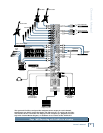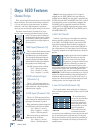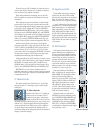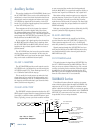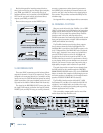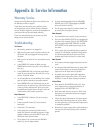
15
Owner’s Manual
Owner’s Manual
WARNING: The headphone amp is
designed to drive any standard head-
phones to a very loud level. We’re
not kidding! It can cause permanent
hearing damage. Even intermediate
levels may be painfully loud with some headphones.
BE CAREFUL! Always start with the PHONES level
turned all the way down before connecting headphones
to the PHONES jack. Keep it down until you’ve put on
the headphones. Then turn it up slowly. Why? Always
remember: “Engineers who fry their ears, fi nd them-
selves with short careers.”
25. SOLO MODE
Engaging a channel’s SOLO switch will cause this
dramatic turn of events: Any existing SOURCE matrix
selections are replaced by the SOLO signal, appearing
at the CONTROL ROOM OUTPUTS, PHONES and at the
RIGHT METER (LEFT and RIGHT METERS when in
AFL SOLO MODE). The audible SOLO levels are then
controlled by the CONTROL ROOM knob (22). The
SOLO levels appearing on the meters are not controlled
by the CONTROL ROOM knob—you wouldn’t want that.
You want to see the actual channel level on the meters
regardless of how loud you’re listening.
With the SOLO MODE switch in the up position, you’re
in PFL mode, meaning Pre-Fader Listen (post-EQ). This
mode is required for the “Set the Levels” procedure and
is handy for quick spot-checks of channels, especially
ones that have their faders turned down.
With the switch down, you’re in AFL mode, meaning
After-Fader Listen. You’ll hear the output of the soloed
channel—it will follow the channel’s GAIN, EQ, FADER
and PAN settings. It’s similar to muting all the other
channels, but without the hassle. Use AFL mode during
mixdown.
In either mode, SOLO will not be affected by a
channel’s MUTE/ALT switch position.
26. LEFT/RIGHT Level Meters
The Onyx 1620’s peak meters are made up of two
columns of twelve LEDs, with three colors to indicate
different ranges of signal level, traffi c light style. They
range from –30 at the bottom, to 0 in the middle, to +20
(CLIP) at the top.
The 0 LED in the middle is labeled LEVEL SET
to show where the level should be when adjusting a
channel’s gain in the solo mode, as described in “Set the
Levels” on page 5.
If nothing is selected in the CONTROL ROOM/
PHONES SOURCE matrix (20) and no channels are
in SOLO, the meters won’t do anything. To display a
signal level, a source must be selected in the CONTROL
ROOM/PHONES SOURCE matrix, which feeds the CON-
TROL ROOM (40) and PHONES (24) outputs. The meters
refl ect the program level of the selected source prior to
the CONTROL ROOM and PHONES (22/23) level knobs.
The reason for this is because you want the meters to
refl ect what the engineer is listening to, and as we’ve
covered, the engineer is listening either to the CON-
TROL ROOM outputs or the PHONES outputs. The only
difference is that while the listening levels are con-
trolled by the CONTROL ROOM and PHONES knobs, the
meters indicated the SOURCE mix before those knobs,
giving you the real facts at all times, even if you’re not
listening at all.
When a channel is soloed, the meters change to
refl ect the level of that channel’s signal level, pre- or
post-fader, depending on the SOLO MODE (25) setting.
You may already be an expert at the
world of “+4” (+4 dBu=1.23 V) and
“–10” (–10 dBV=0.32 V) operating
levels. What makes a mixer one or
the other is the relative 0 dB VU (or
0 VU) chosen for the meters. A “+4”
mixer, with +4 dBu pouring out the back will actually
read 0 VU on its meters. A “–10” mixer, with a –10 dBV
signal trickling out will read, you guessed it, 0 VU on its
meters. So when is 0 VU actually 0 dBu? Right now!
Mackie mixers show things as they really are. When 0
dBu (0.775 V) is at the outputs, it shows as 0 dB VU on
the meters. What could be easier? By the way, the most
wonderful thing about standards is that there are so
many to choose from.
Thanks to the Onyx 1620’s wide dynamic range,
you can get a good mix with peaks fl ashing anywhere
between –20 and +10 dB on the meters. Most amplifi ers
clip at about +10 dBu, and some recorders aren’t so
forgiving either. For best real-world results, try to keep
your peaks between “0” and “+7.”
Remember, audio meters are just tools to help assure
you that your levels are “in the ballpark.” You don’t have
to stare at them (unless you want to).
27. RUDE SOLO Light
This large green LED fl ashes on and off when a
channel’s solo is active, as an additional reminder
beyond the indicating LEDs next to each SOLO button.
If you work on a mixer that has a solo function with no
indicator lights and you happen to forget you’re in solo
mode, you can easily be tricked into thinking that some-
thing is wrong with your mixer. Hence, the RUDE SOLO
light. It’s especially handy at about 3 am when no sound
is coming out of your monitors but your multitrack is
playing back like mad.





